Low-Temperature Esterification to Produce Oleic Acid-Based Wax Esters Catalyzed by 4-Dodecylbenzenesulfonic Acid
Abstract
:1. Introduction
2. Results and Discussion
2.1. Fatty Acid Composition of Oleic Acid from High-Oleic Sunflower Seed Oil
2.2. Screening of Catalysts
2.3. Effect of Reaction Parameters
2.4. Effect of the Water Content on Esterification
2.5. Mechanism of Wax Esters Synthesis with DBSA Catalyst
2.6. Comparison of Different Acyl Donors in DBSA-Catalyzed Reactions
2.7. Analysis and Separation of Cetyl Oleate Wax Ester
2.8. Synthesis of Different Oleic Acid-Based Wax Esters
3. Materials and Methods
3.1. Materials
3.2. Production of Fatty Acids
3.3. Synthesis of Wax Esters
3.4. Determination of Wax Esters
3.5. Purification of Wax Esters Product
3.6. Characterization of Purified Wax Esters
3.7. Data Analysis
4. Conclusions
Supplementary Materials
Author Contributions
Funding
Data Availability Statement
Conflicts of Interest
References
- Doan, C.D.; To, C.M.; De Vrieze, M.; Lynen, F.; Danthine, S.; Brown, A.; Dewettinck, K.; Patel, A.R. Chemical profiling of the major components in natural waxes to elucidate their role in liquid oil structuring. Food. Chem. 2017, 214, 717–725. [Google Scholar] [CrossRef] [PubMed]
- Aguieiras, E.C.G.; Papadaki, A.; Mallouchos, A.; Mandala, I.; Sousa, H.; Freire, D.M.G.; Koutinas, A.A. Enzymatic synthesis of bio-based wax esters from palm and soybean fatty acids using crude lipases produced on agricultural residues. Ind. Crop. Prod. 2019, 139, 1–6. [Google Scholar] [CrossRef]
- Li, J.J. Quantitative Analysis of Cosmetics Waxes by Using Supercritical Fluid Extraction (SFE)/Supercritical Fluid Chromatography (SFC) And Multivariate Data Analysis. Chemometr. Intell. Lab. 1999, 45, 385–395. [Google Scholar] [CrossRef]
- Ungcharoenwiwat, P.; H-Kittikun, A. Synthesis of Wax Esters from Crude Fish Fat by Lipase of Burkholderiasp. EQ3 and Commercial Lipases. J. Am. Oil. Chem. Soc. 2013, 90, 59–67. [Google Scholar] [CrossRef]
- Khalkar, S.; Bhowmick, D.; Pratap, A. Effect of Wax Esters as Friction modifiers in petroleum base stock. J. Oleo. Sci. 2012, 61, 723–728. [Google Scholar] [CrossRef] [PubMed] [Green Version]
- Bi, Y.C.; Yu, M.; Zhou, H.Y. Biosynthesis of oleyl oleate in solvent-free system by Candida rugosa Lipase (CRL) immobilized in macroporous resin with cross-linking of aldehyde-dextran. J. Mol. Catal. B-Enzym. 2016, 133, 1–5. [Google Scholar] [CrossRef]
- Deng, L.; Wang, X.J.; Nie, K.L.; Wang, F.; Liu, J.F.; Wang, P.; Tan, T.W. Synthesis of Wax Esters by Lipase-catalyzed Esterification with Immobilized Lipase from Candida sp. 99–125. Chinese. J. Chem. Eng. 2011, 19, 978–982. [Google Scholar]
- Keng, P.S.; Basri, M.; Zakaria, M.R.S.; Rahman, M.B.A.; Ariff, A.B.; Rahman, R.N.Z.A.; Salleh, A.B. Newly synthesized palm esters for cosmetics industry. Ind. Crop. Prod. 2009, 29, 37–44. [Google Scholar] [CrossRef]
- Al-Arafi, N.; Salimon, J. Production of Oleic Acid Based Wax Ester Using Acidic Homogeneous Catalysts. E-J. Chem. 2012, 9, 99–106. [Google Scholar] [CrossRef]
- Aracil, J.; Martinez, M.; Sánchez, N.; Corma, A. Formation of jojoba oil analog by esterification of oleic acid using zeolite as catalyst. Zeolites 1992, 12, 233–236. [Google Scholar] [CrossRef]
- Ieda, N.; Mantri, K.; Miyata, Y.; Ozaki, A.; Komura, K.; Sugi, Y. Esterification of Long-Chain Acids and Alcohols Catalyzed by Ferric Chloride Hexahydrate. Ind. Eng. Chem. Res. 2008, 47, 8631–8638. [Google Scholar] [CrossRef]
- Aissa, I.; Sellami, M.; Kamoun, A.; Gargouri, Y.; Miled, N. Optimization of Immobilized Lipase-Catalyzed Synthesis of Wax Esters by Response Surface Methodology. Curr. Chem. Biol. 2012, 6, 77–85. [Google Scholar]
- Alegría, A.; Cuellar, J. Esterification of oleic acid for biodiesel production catalyzed by 4-dodecylbenzenesulfonic acid. Appl. Catal. B-Environ. 2015, 179, 530–541. [Google Scholar] [CrossRef]
- Manabe, K.; Sun, X.M.; Kobayashi, S. Dehydration reactions in water. Surfactant-type Brønsted acid-catalyzed direct esterification of carboxylic acids with alcohols in an emulsion system. J. Am. Chem. Soc. 2001, 123, 10101–10102. [Google Scholar] [CrossRef] [PubMed]
- Li, G.; Li, X.Z.; Eli, W. Solvent-free esterification catalyzed by surfactant-combined catalysts at room temperature. New. J. Chem. 2007, 31, 348–351. [Google Scholar]
- Manabe, K.; Iimura, S.; Sun, X.M.; Kobayashi, S. Dehydration Reactions in Water. Brønsted Acid−Surfactant-Combined Catalyst for Ester, Ether, Thioether, and Dithioacetal Formation in Water. J. Am. Chem. Soc. 2002, 124, 11971–11978. [Google Scholar] [CrossRef] [PubMed]
- Aafaqi, R.; Mohamed, A.R.; Bhatia, S. Kinetics of esterification of palmitic acid with isopropanol using p-toluenesulfonic acid and zinc ethanoate supported over silica gel as catalysts. J. Chem. Technol. Biot. 2004, 79, 1127–1134. [Google Scholar] [CrossRef]
- Aranda, D.A.G.; Santos, R.T.P.; Tapanes, N.C.O.; Ramos, A.L.D.; Antunes, O.A.C. Acid-Catalyzed Homogeneous Esterification Reaction for Biodiesel Production from Palm Fatty Acids. Catal. Lett. 2008, 122, 20–25. [Google Scholar] [CrossRef]
- Liu, W.; Xiao, B.; Yang, G.L.; Bi, Y.L.; Chen, F.S. Rapid Salt-Assisted Microwave Demulsification of Oil-Rich Emulsion Obtained by Aqueous Enzymatic Extraction of Peanut Seeds. Eur. J. Lipid Sci. Technol. 2020, 122, 1900120. [Google Scholar] [CrossRef]
- Liu, W.; Xiao, B.; Wang, X.; Chen, J.; Yang, G.L. Solvent-free synthesis of phytosterol linoleic acid esters at low temperature. RSC Adv. 2021, 11, 10738–10746. [Google Scholar] [CrossRef]

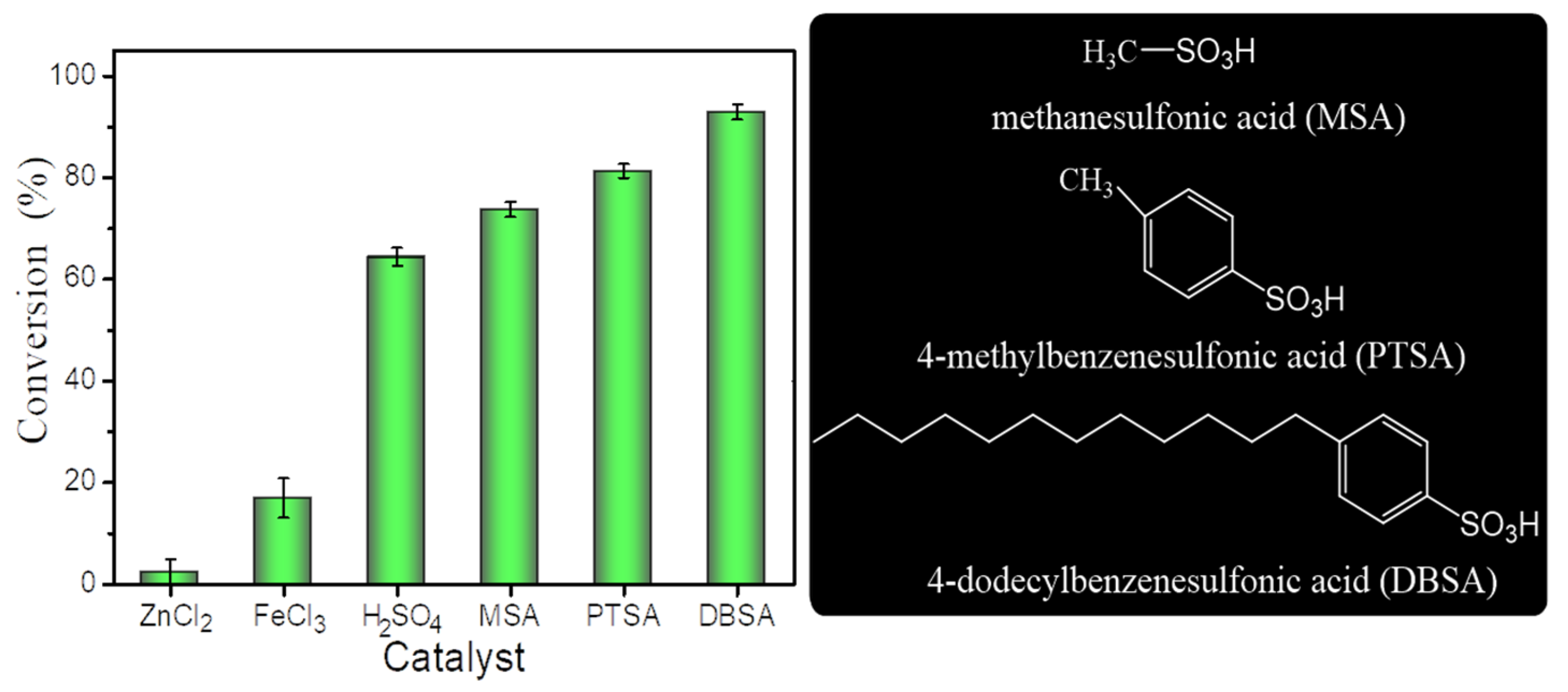
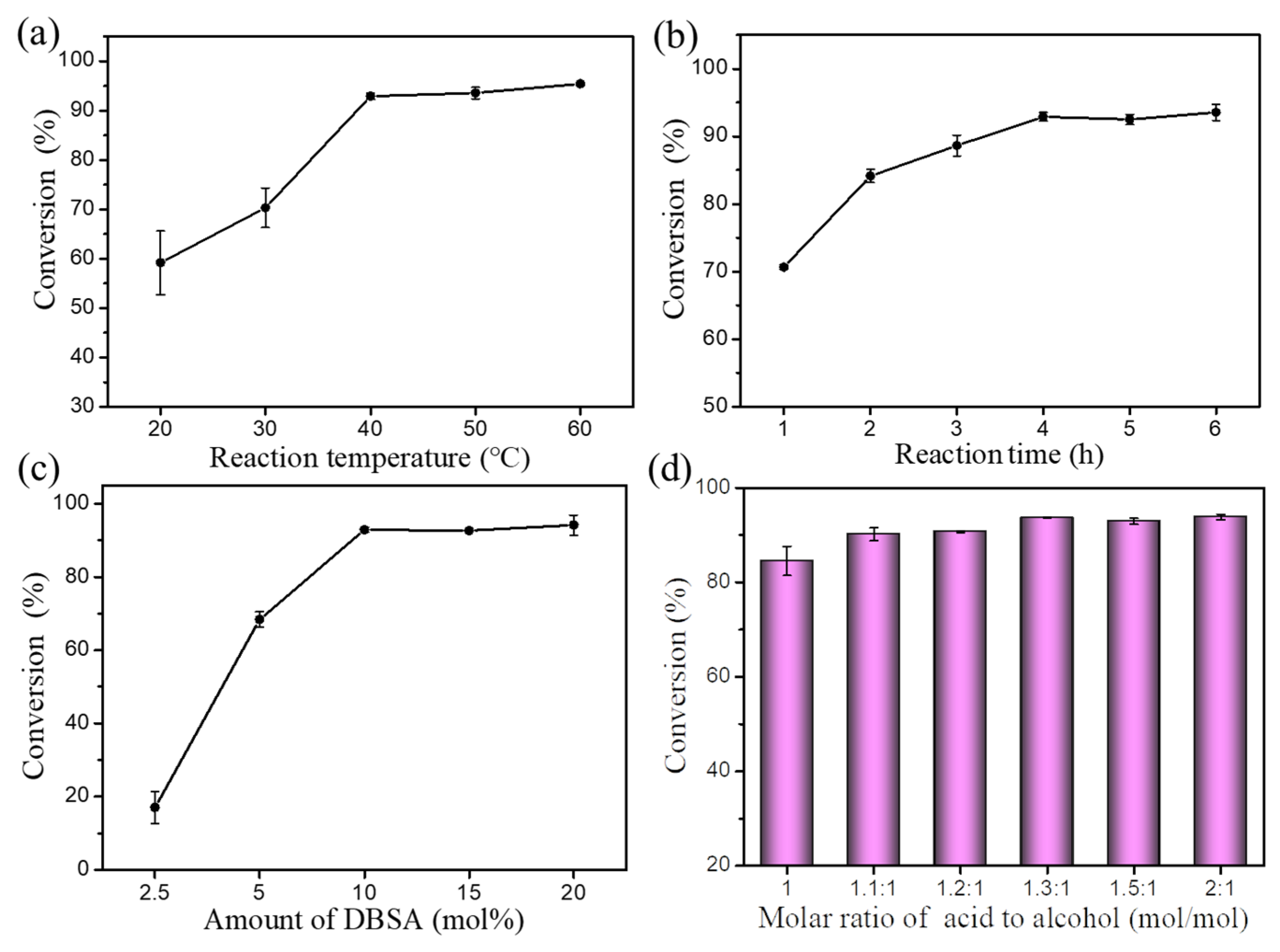
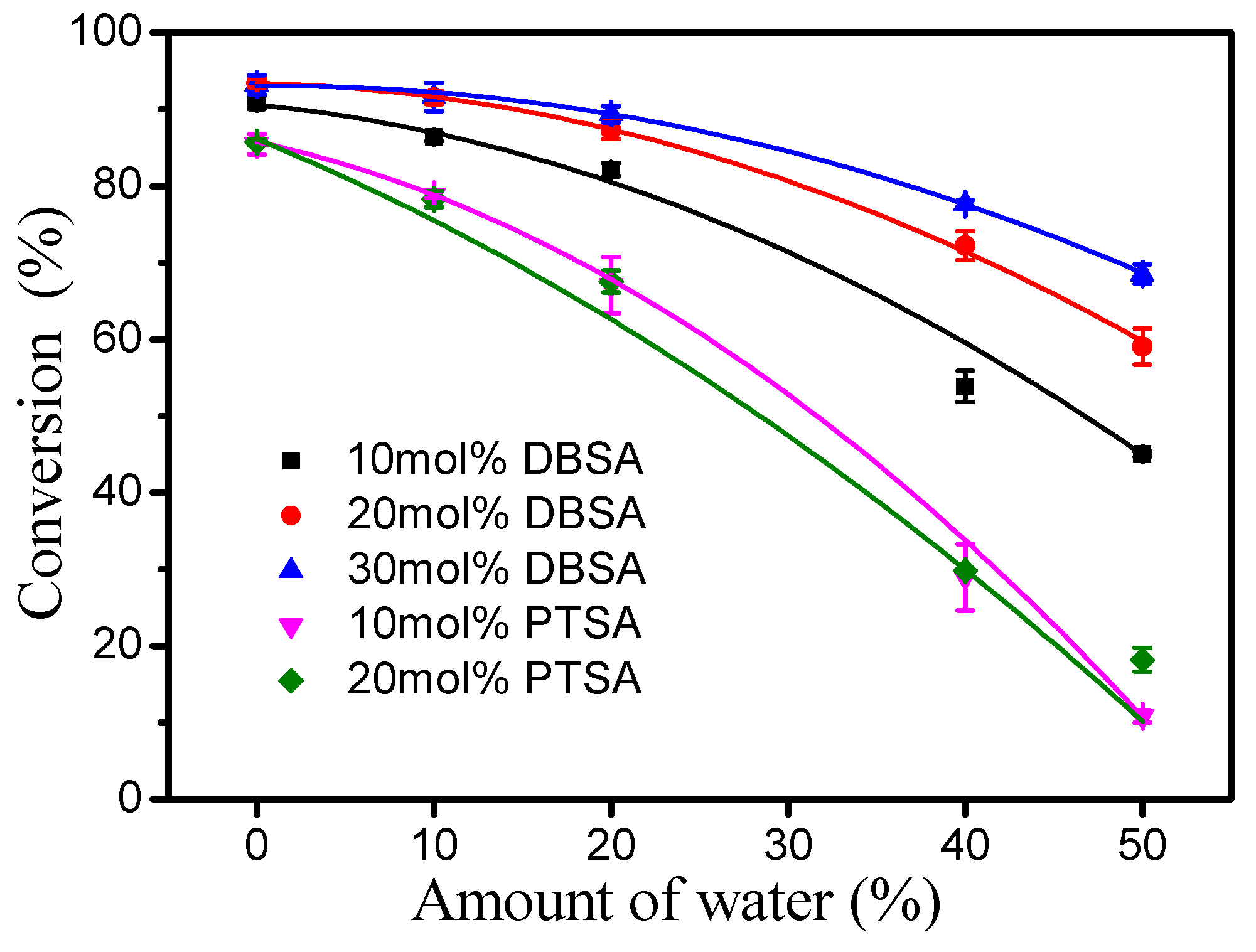
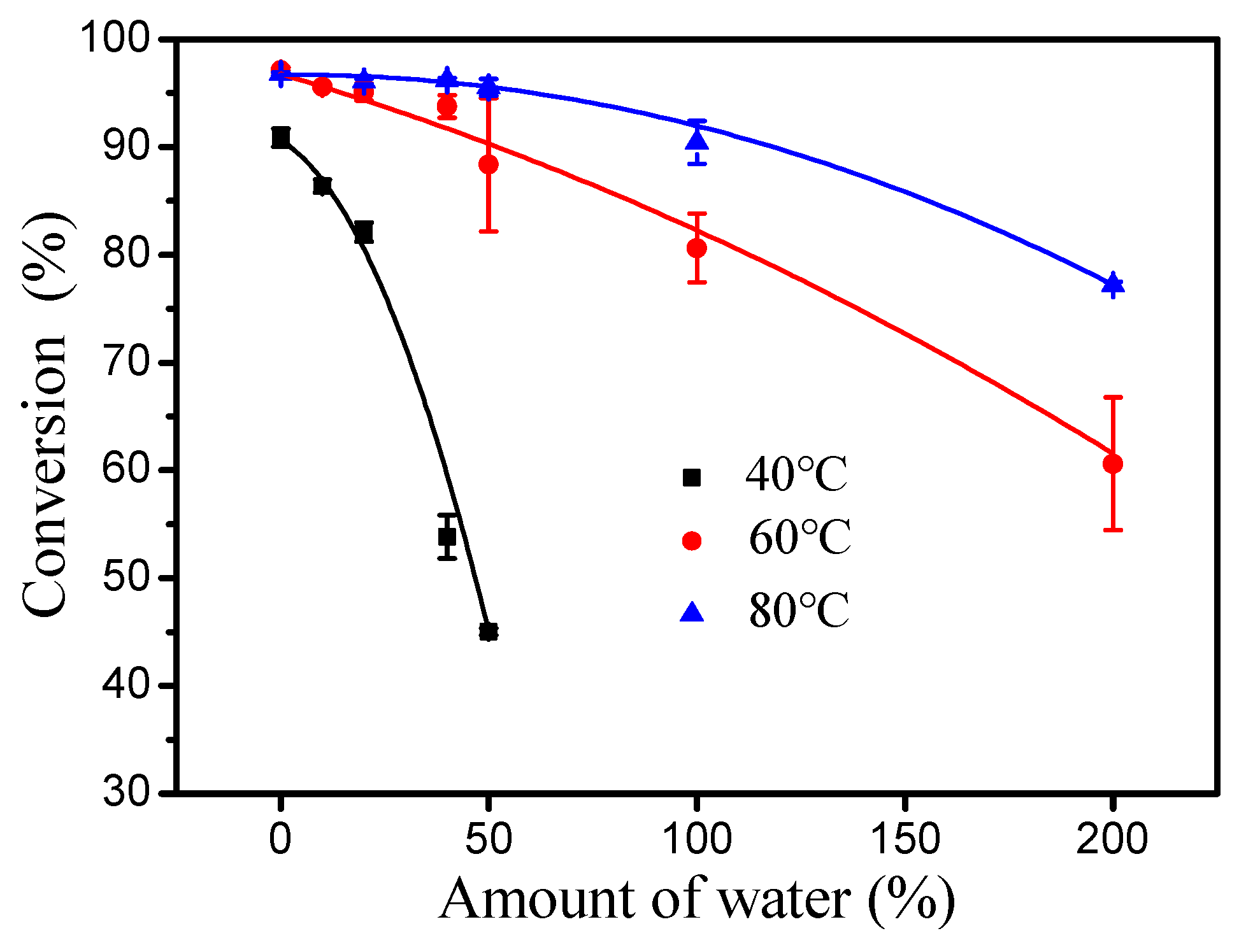


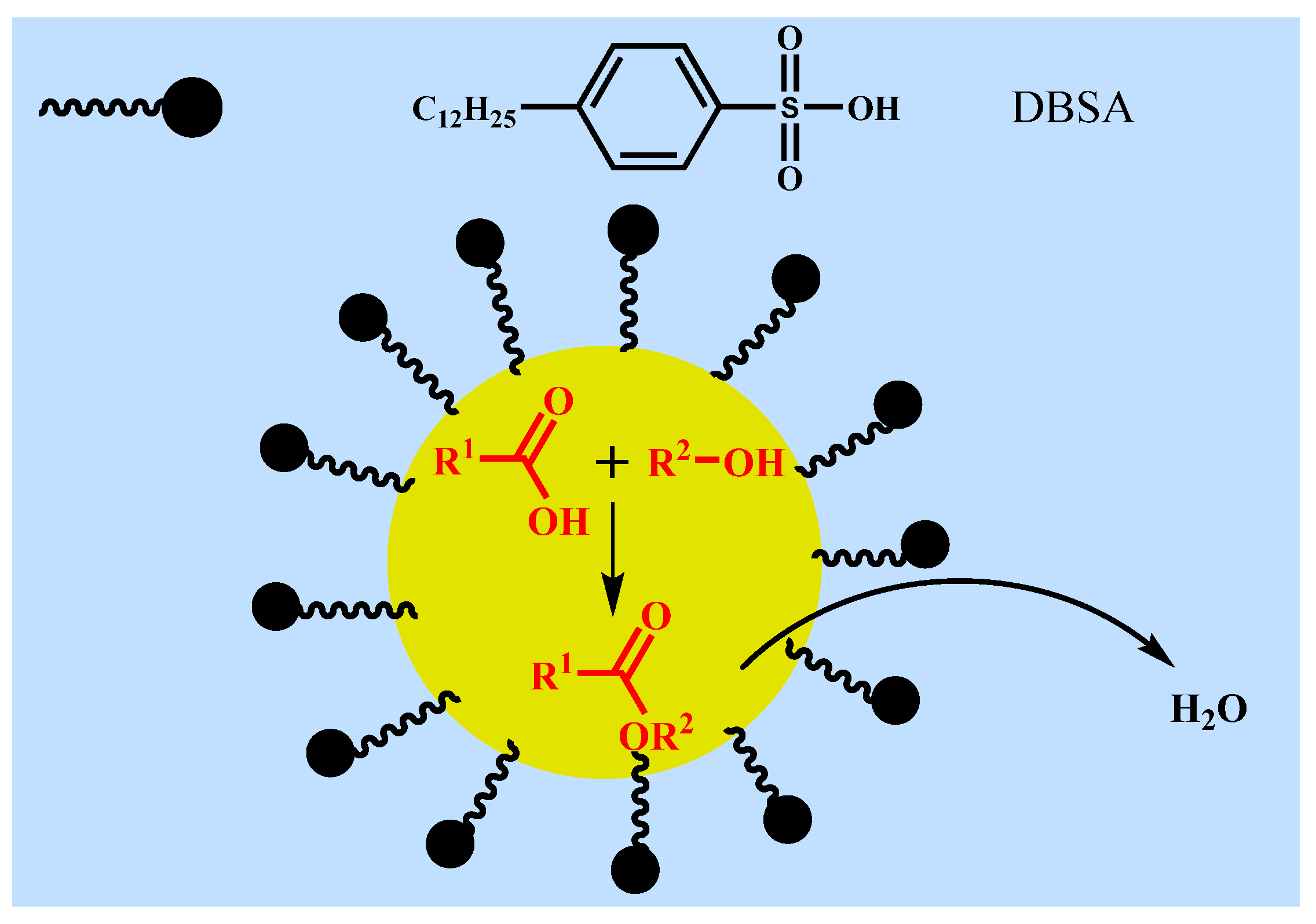
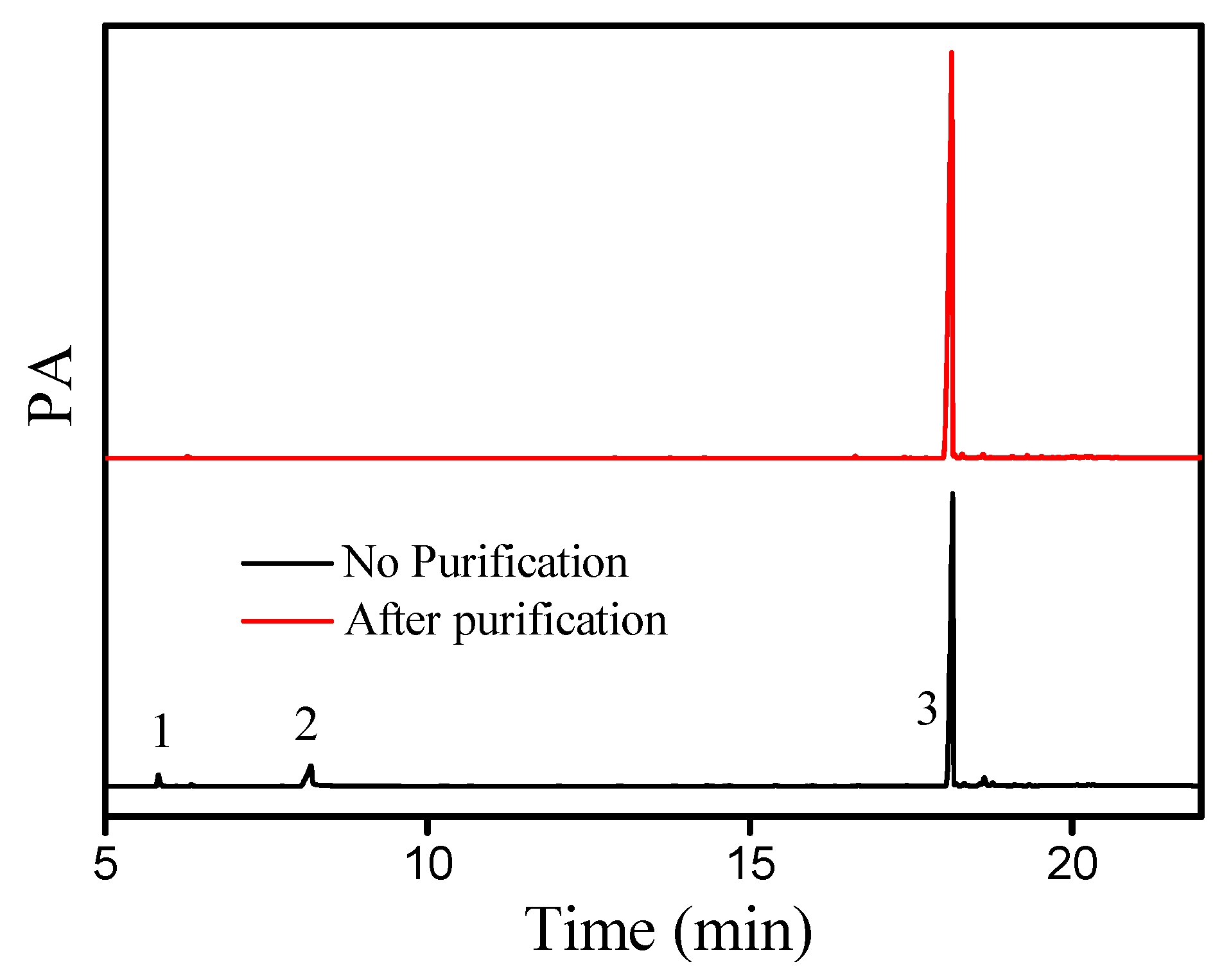
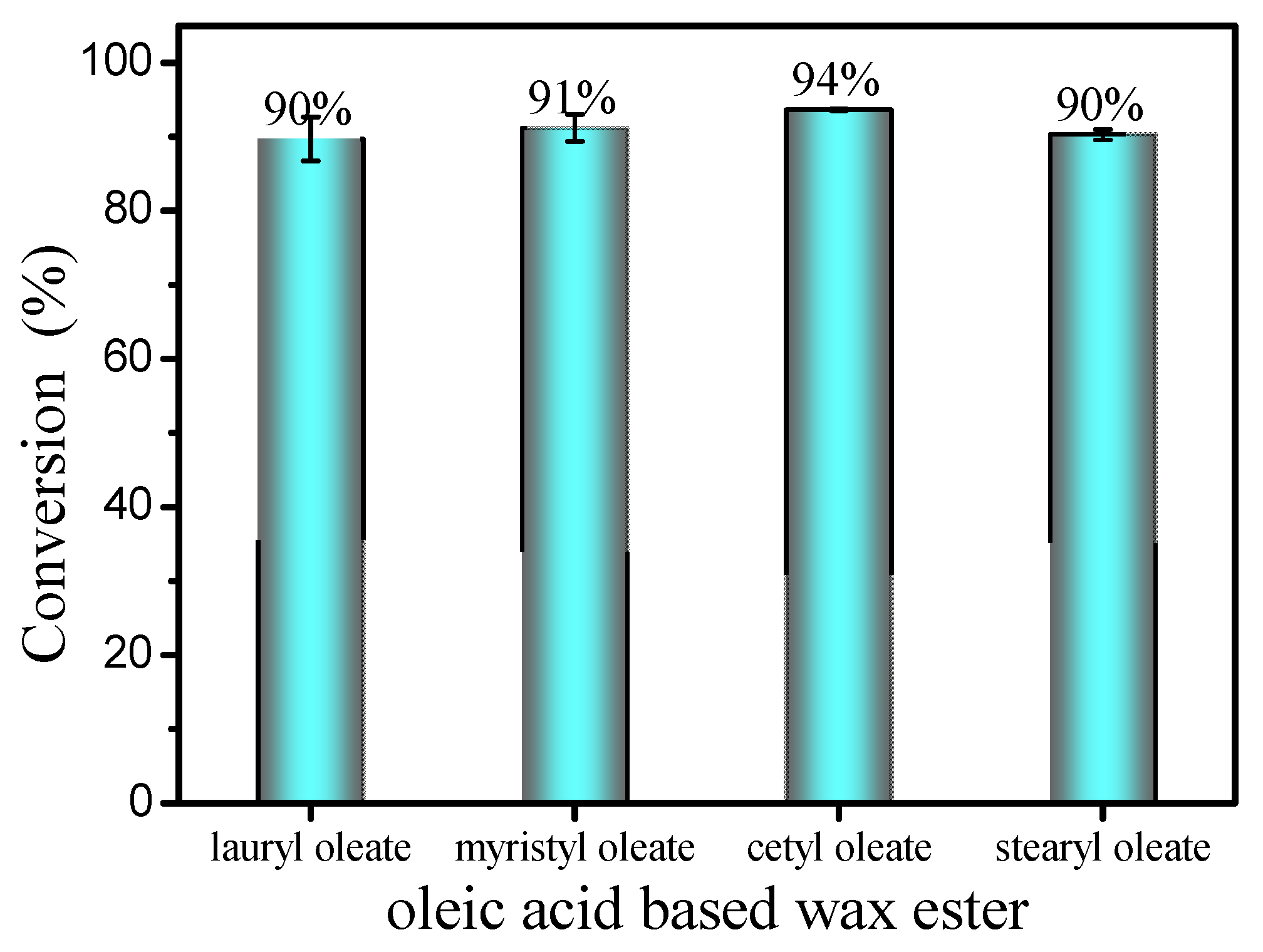
| Acyl Donors | Temperature (°C) | Conversion (%) |
|---|---|---|
| Oleic acid 1 | 40 | 93.3 ± 0.49 a |
| Oleic acid 2 | 40 | 93.7 ± 0.11 a |
| Oleic acid 3 | 40 | 94.0 ± 0.13 a |
| High-oleic sunflower oil | 40 | 11.4 ± 0.92 c |
| High-oleic sunflower oil | 80 | 78.0 ± 1.84 b |
| Reaction Condition | Conversion (%) |
|---|---|
| Open test tube | 92.4 ± 1.06 a |
| Closed test tube | 93.7 ± 0.11 a |
Publisher’s Note: MDPI stays neutral with regard to jurisdictional claims in published maps and institutional affiliations. |
© 2021 by the authors. Licensee MDPI, Basel, Switzerland. This article is an open access article distributed under the terms and conditions of the Creative Commons Attribution (CC BY) license (https://creativecommons.org/licenses/by/4.0/).
Share and Cite
Li, Z.; Liu, W.; Yang, G. Low-Temperature Esterification to Produce Oleic Acid-Based Wax Esters Catalyzed by 4-Dodecylbenzenesulfonic Acid. Catalysts 2021, 11, 1471. https://doi.org/10.3390/catal11121471
Li Z, Liu W, Yang G. Low-Temperature Esterification to Produce Oleic Acid-Based Wax Esters Catalyzed by 4-Dodecylbenzenesulfonic Acid. Catalysts. 2021; 11(12):1471. https://doi.org/10.3390/catal11121471
Chicago/Turabian StyleLi, Zhenzhen, Wei Liu, and Guolong Yang. 2021. "Low-Temperature Esterification to Produce Oleic Acid-Based Wax Esters Catalyzed by 4-Dodecylbenzenesulfonic Acid" Catalysts 11, no. 12: 1471. https://doi.org/10.3390/catal11121471






